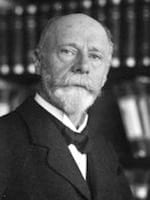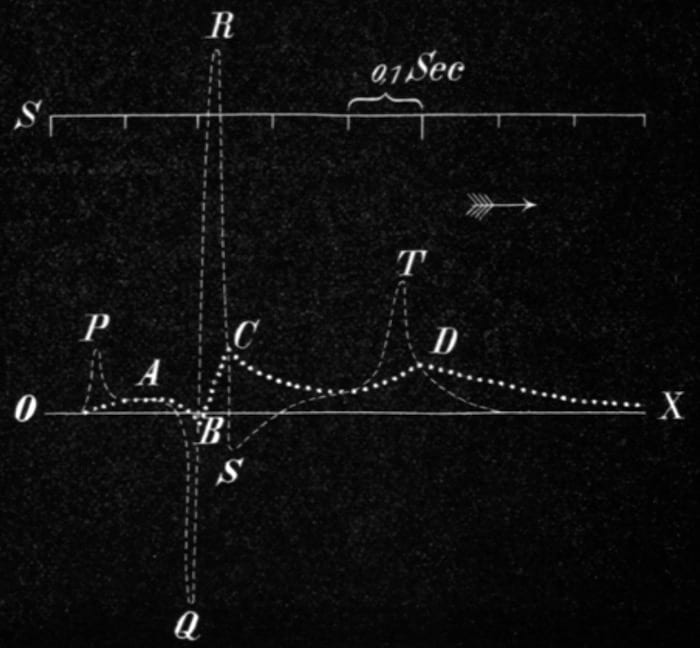Willem Einthoven
Willem Einthoven (1860 – 1927) was a Dutch physician and physiologist.
Einthoven was the the founder of modern electrocardiography and recognized the great potential importance of the ECG as a diagnostic and investigative tool.
Invented the first practical electrocardiogram (ECG) in 1903. Awarded the Nobel Prize in Physiology or Medicine 1924 for his ‘discovery of the mechanism of the electrocardiogram‘.
Biography
- Born on May 21, 1860 Semarang, Java
- 1870 – Returned to Holland aged 10
- 1885 – Doctorate, University of Utrecht
- 1886 – Professor of physiology at the University of Leiden
- Died on September 29, 1927
Medical Eponyms
- Einthoven string galvanometer (Saitengalvanometer) (1901)
- Einthoven law
- Einthoven triangle (1912)
Key Medical Attributions
1893 – Einthoven introduces the term ‘electro-cardiogrammem‘ at a meeting of the Dutch Medical Association [Nieuwemethoden voor clinisch onderzoek [New methods for clinical investigation]. Nederlands Tijdschrift voor Geneeskunde. 1893; 29(II): 263-286]
1895 – Einthoven derived a correction formula that compensated for the inertia and friction when using the mercury column of the Lippmann capillary electrometer. Einthoven superimposed the mathematically corrected curve on the uncorrected curve. He had previously used ABCD to indicate the waves in the uncorrected tracing, and was forced to find other letters to label his corrected curve. He labeled the corrected derived deflections PQRS and T. [Ueber die Form des menschlichen Electrocardiogramms. 1895; 60 (3-4): 101-123.] The choice of letters is still debated, but most likely based on a mathematical convention dating from Descartes starting with the letter P to identify successive points on a curve.
String galvanometer
Having seen a demonstration of the “electrogram” by Augustus D Waller in 1887 (a device that recorded minute deviations on a mercury column when electrically stimulated), he improved it by creating the “string galvanometer” in 1901.
It gives me an especial pleasure to bring to remembrance here that the human EKG. was first recorded by a London physiologist, Augustus D. Waller, who also introduced the term “electrocardiogram” into science; and that Dr. Thomas Lewis, whose extensive researches have been crowned with such exceptional success, was the first man in England who applied electrocardiography to clinical investigations. The method of electrocardiography is still a young plant. We may reasonably expect that it will continue to bear good fruit.
Einthoven 1912
1902 – Einthoven published the first ECG in his article Galvanometrische registratie van het menschelijk electrocardiogram in: Herinneringsbundel Prof. S.S. Rosenstein. 1902: 101-106
1905 – Einthoven provides the first organised presentation of normal and abnormal electrocardiograms recorded with his string galvanometer and recording apparatus in his laboratory. He presented cases of atrial and ventricular hypertrophy; ventricular bigeminy, ventricular premature beats and he introduced the U wave…
Of note the electrocardiograms recorded had been transmitted via telephone wire from the patients in a hospital some distance 1500m away! The first of these ‘telecardiogram’s’ was sent and recorded on March 22nd 1905. [Le Télécardiogramme. Archives internationales de physiologie. 1906;4:132-164]
1908 – Einthoven’s 1903 paper reporting the recording of the ECG with a string galvanometer developed by himself attracted little attention from the medical profession. However, following the publication of the paper, “More about the electrocardiogram,” Einthoven was besieged by visitors and received correspondence from individuals all over Europe who wanted to see or learn about the new instrument. In this publication, he referred to the contributions of Sunao Tawara 田原 淳, (1873 – 1952) as the theoretical basis for interpreting electrocardiograms.
Nach den Untersuchungen Tawara’s besteht das atrioventrikulare Verbindüngsbfindel aus einem System vonMuskelfasern, die einen sich baumförmig verzweigenden Strang bilden…Völlig in glbereinstimmung mit diesem anatomischen Bau ist die Fortpfianzung der Kontraktionswelle im Herzen, wie dieselbe aus tier Form des Elektrokardiogrammes abgeleitet werden muss.
Einthoven 1908: 576
According to Tawara’s study, the atrioventricular connecting bundle consists of a system of muscle fibers which form a tree-like ramified cord…The mode of propagation of the contraction wave in the heart, as it must be deduced from the form of the electrocardiogram, is in complete accordance with this anatomical structure.
Einthoven 1908: 576
Einthoven triangle
1912 – At an address to the Chelsea Clinical Society on March 19th 1912, Einthoven outlined his schema of the equilateral triangle formed by his standard leads I, II and III (Einthoven triangle) [The different forms of the human electrocardiogram and their signification. Lancet 1912; 179(4622): 853-861.]
Einthoven most commonly used the term electrocardiogram in English publications, reserving elektrokardiogramm for non-English publications, though there was little consistency in the regard. In his landmark 1912 paper, he refers to the ‘electrocardiogram (EKG)‘
Major Publications
- Einthoven W. Nieuwemethoden voor clinisch onderzoek [New methods for clinical investigation]. Nederlands Tijdschrift voor Geneeskunde. 1893; 29(II): 263-286 [Introduces term electro-cardiogrammem]
- Einthoven W. Lippmann’s Capillar-Electrometer zur Messung schnell wechselnder Potentialunterschiede. Archiv für die gesamte Physiologie des Menschen und der Tiere. 1895; 56(10-12: 528–541
- Einthoven W. Ueber die Form des menschlichen Electrocardiogramms. Archiv für die gesamte Physiologie des Menschen und der Tiere. 1895; 60 (3-4): 101-123.
- Einthoven W, de Lint K. Ueber das normale menschliche Elektrokardiogramm und über die capillar-elektrometrische Untersuchung einiger Herzkranken. Archiv für die gesamte Physiologie des Menschen und der Tiere. 1900; 80(3-5): 139-160
- Einthoven W. Un nouveau galvanomètre. Archives Neerlandaises des sciences exactes et naturelles 1901; 6: 625-633.
- Einthoven W. Galvanometrische registratie van het menschelijk electrocardiogram. In: Herinneringsbundel Prof. S.S. Rosenstein. 1902: 101-106
- Einthoven W. Die galvanometrische Registrirung des menschlichen Elektrokardiogramms, zugleich eine Beurtheilung der Anwendung des Capillar-Elektrometers in der Physiologie. Archiv für die gesamte Physiologie des Menschen und der Tiere. 1903; 99(9-10): 472-480
- Einthoven W. Le Télécardiogramme. Archives internationales de physiologie. 1906; 4: 132-164 (translated into English, The Telecardiogram. Am Heart J 1957;53(4): 602-615)
- Einthoven W. Flohil A, Battaerd PJJA. Die Registrirung der menschlichen Herztöne mittels des Saitengalvanometers. Archiv für die gesamte Physiologie des Menschen und der Tiere. 1907; 117(7-9): 461-472
- Einthoven W. Weiteres über das Elektrokardiogramm. Archiv für die gesamte Physiologie des Menschen und der Tiere. 1908; 122(12): 517–584
- Einthoven W. The different forms of the human electrocardiogram and their signification. Lancet 1912; 179(4622): 853-861.
- Einthoven W, Fahr G, De Waart A. Über die Richtung und die manifeste Grösse der Potentialschwankungen im menschlichen Herzen und über den Einfluss der Herzlage auf die Form des Elektrokardiogramms. Pflüger’s Archiv für die gesamte Physiologie des Menschen und der Tiere. 1913; 150(6-8): 275–315.
- Einthoven W. The string galvanometer and the measurement of the action currents of the heart (Nobel Lecture, December 11, 1925)
References
Biography
- Gottlieb LS. Willem EINTHOVEN, M.D., Ph.D., 1860-1927. Centenary of the father of electrocardiography. Arch Intern Med. 1961 Mar;107:447-9.
- Luyendijk-Elshout AM. Einthoven, Willem (1860-1927) in: Biografisch Woordenboek van Nederland
- Silverman ME. Willem Einthoven–the father of electrocardiography. Clin Cardiol. 1992;15(10):785-787.
- Snellen HA. Willem Einthoven 1860-1927 Father of electrocardiography: Life and work, ancestors and contemporaries. Springer; 1995
- Moukabary T. Willem Einthoven (1860-1927): Father of electrocardiography. Cardiol J. 2007;14(3):316-317.
- Merritt C, Tan SY. Willem Einthoven (1860-1927): father of electrocardiography. Singapore Med J. 2012;53(1):17-18.
- Bibliography. Einthoven, Willem 1860-1927. WorldCat Identities
Eponymous terms
- Presentation Speech: The Nobel Prize in Physiology or Medicine 1924. – NobelPrize.org
- Wilson FN. On the possibility of constructing an Einthoven triangle for a given subject. Am Heart J. 1949; 37(4): 493-522.
- Snellen HA. Selected Papers on Electrocardiography of Willem Einthoven: with Bibliography, Biographical Notes and Comments. Leiden University Press, Leiden; 1977.
- Ershler I. Willem Einthoven–the man. The string galvanometer electrocardiograph. Arch Intern Med. 1988;148(2):453-455.
- Rivera-Ruiz M, Cajavilca C, Varon J. Einthoven’s string galvanometer: the first electrocardiograph. Tex Heart Inst J. 2008;35(2):174-178.
- Kligfield P. Derivation of the correct waveform of the human electrocardiogram by Willem Einthoven, 1890-1895. Cardiol J. 2010;17(1):109-113.
- Piccolino M. Luigi Galvani’s path to animal electricity. C R Biol. 2006;329(5-6):303-318.
- Willem Einthoven ~ The Electrocardiogram: Video.
- Eponymythology. History of the Electrocardiogram. LITFL
[cite]




